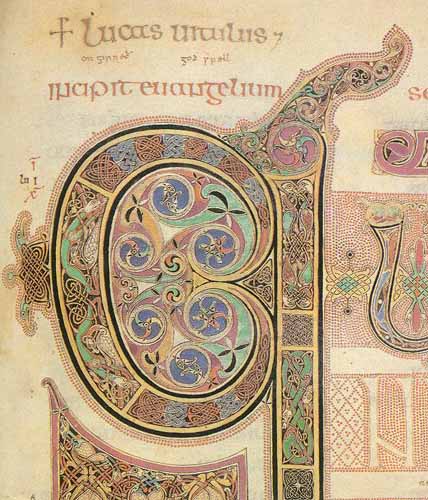
The Decorated Letter, at the J. Paul Getty Museum, the Getty Center, November 13, 2007-January 27, 2008, explores the stylistic traditions of decorated initials preserved from a period that spans over 700 hundred years. Exhibition materials are primarily drawn from books of scripture and prayer, with a few examples from the realms of law and history, and provide insight into the trends that shaped medieval artistic production.
The exhibition complements the Getty's Fall Premiere Presentation Medieval Treasures from the Cleveland Museum of Art.
Throughout the Middle Ages, handwritten manuscripts were elaborately decorated with initials that called attention to the important part of a text, testified to the authority of the written word of God, and brought the vibrancy of speech and song to the manuscript page. Medieval initials were often intricately designed, lavished with gold, and painted with expensive pigments.
This display of 25 manuscripts and leaves from the Getty Museum's collection presents some of the most beautifully decorated initials in manuscripts, tracing the sophisticated relationship between pictures and words in three major categories of decorated letters: ornamented, inhabited or figurative, and historiated.
This display of 25 manuscripts and leaves from the Getty Museum's collection presents some of the most beautifully decorated initials in manuscripts, tracing the sophisticated relationship between pictures and words in three major categories of decorated letters: ornamented, inhabited or figurative, and historiated.
Ornamented letters were among the earliest decorated letters applied by medieval manuscript artists. They are usually adorned with foliage or vegetal motifs that range from carefully interlaced, stylized forms to more naturalistic renderings of lush vegetation. In the context of Christian religious service and prayer books, luxurious foliage and vegetal patterns expressed the medieval belief in the life-giving power of the word of God.
People, animals, and fantastic beasts appear in two types of initials that engaged the reader's attention and provoked curiosity about the text the letters introduced. In inhabited letters, figures climb on, crawl through, or emerge from decorative forms. In figurative letters, the contoured bodies of people or creatures form the shape of the letter itself.
Historiated letters contain distinct scenes or subject matter specifically related to the texts they introduce. The earliest historiated letters were simple illustrations of the biblical or historical figure to which a text was attributed. Later examples depicted elements of an important story or scene from the text.
This exhibition also includes an example of a Renaissance constructed alphabet by Joris Hoefnagel, arguably the last great manuscript illuminator. In stark contrast to the animated initials in medieval books, Hoefnagel's Model Book of Calligraphy provides a geometric template and a completed character for each letter of the alphabet.
The Decorated Letter is curated by Richard Leson, a former intern in the Department of Manuscripts at the J. Paul Getty Museum. -- http://www.getty.edu/


No comments:
Post a Comment